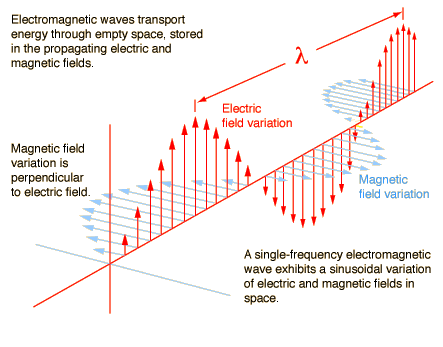
Electromagnetic waves are formed when an electric field (shown as blue arrows) couples with a magnetic field (shown as red arrows). The combination of oscillating electrical and magnetic fields of the electromagnetic waves are perpendicular to each other and to the direction of the wave. James Clerk Maxwell and Heinrich Hertz are two scientists who studied how electromagnetic waves are formed and how fast they travel.This is difficult to visualize, however the waveform has similar characteristics of other types of waves.
Although they seem different, radio waves, microwaves, x-rays, and even visible light are all electromagnetic waves are part of the electromagnetic spectrum, and each has a different range of wavelengths, which cause they waves to affect matter differently.The creation and detection of the wave depend much on the range of wavelengths.
Electromagnetic spectrum
The range of wavelengths for electromagnetic waves--from the very long to the very short--is called the Electromagnetic Spectrum:
* Radio and TV waves are the longest usable waves, having a wavelength of 1 mile
(1.5 kilometer) or more.
* Microwaves are used in telecommunication as well as for cooking food.
* Infrared waves are barely visible. They are the deep red rays you get from a heat lamp.
* Visible light waves are the radiation you can see with your eyes. Their wavelengths are in the range of 1/1000 centimeter.
* Ultraviolet rays are what give you sunburn and are used in "black lights" that make object glow.
* X-rays go through the body and are used for medical purposes.
* Gamma rays are dangerous rays coming from nuclear reactors and atomic bombs. They have the shortest wavelength in the electromagnetic spectrum of about 1/10,000,000 centimeter.


(Click on picture to get full view)
Waves in the electromagnetic spectrum vary in size from very long radio waves the size of buildings, to very short gamma-rays smaller than the size of the nucleus of an atom.
Did you know that electromagnetic waves can not only be described by their wavelength, but also by their energy and frequency? All three of these things are related to each other mathematically. This means that it is correct to talk about the energy of an X-ray or the wavelength of a microwave or the frequency of a radio wave. The electromagnetic spectrum includes, from longest wavelength to shortest: radio waves, microwaves, infrared, optical, ultraviolet, X-rays, and gamma-rays.
There are no gaps in between the electromagnetic spectrum.It is possible to find all possible frequencies that exist in this range.There is no boundary between one type of electromagnetic waves and the next.
(To Take Note:)
Gamma Rays - highest frequency, lowest wavelength
Radio waves - lowest frequency, longest wavelength
Visible light is just one of the 7 members of the family of electromagnetic waves
-------------------------------------------------------------------------------------
Look at the picture of the electromagnetic spectrum. See if you can find answers to these questions:
1. What kind of electromagnetic radiation has the shortest wavelength? The longest?
2. What kind of electromagnetic radiation could be used to "see" molecules? A cold virus?
3. Why can't you use visible light to "see" molecules?
4. Some insects, like bees, can see light of shorter wavelengths than humans can see. What kind of radiation do you think a bee sees?
-------------------------------------------------------------------------------------
Properties
1. Electromagnetic Waves are transverse waves.They are magnetic and electric fields of an electromagnetic wave which are perpendicular to each other and to the direction of the wave.

2.They transfer energy from one place to another.
3.They can travel through vacuum.They don't require any medium to travel from one point to another.
4.They can travel at the speed of light, 3.0 x 10*8 m/s but, will slow down when travelling through water or glass.
5.Equation of wave velocity also applies for electromagnetic waves,
Speed = Wavelength • Frequency
6.They obey Snell's laws of Reflection and Refraction.
7.They carry no electric charges as they are neither positively charged nor negatively charged.
8.The frequencies do not change when they travel from one medium to another as their frequency depends only on the source of the wave.Only their speeds and wavelengths change from one medium to another.
Your blog is so interesting and very informative; the quality you used in penning this is excellent. Thanks for posting this.
ReplyDeletewww.n8fan.net